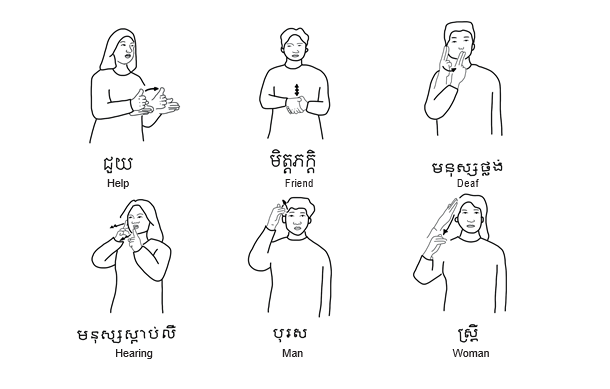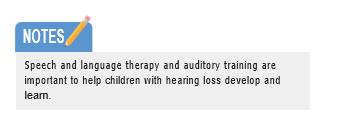Content begins here
Main page content
Click to collapse
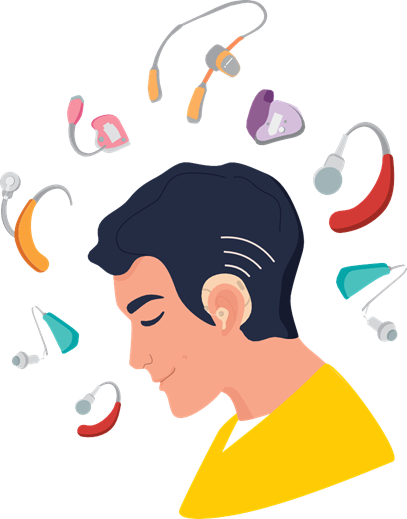 LEARNING OBJECTIVES
LEARNING OBJECTIVES
By the end of this module the learner should be able to:
• Explain why early identification and intervention for hearing loss is important
• List the ways and means for rehabilitation of persons with hearing loss
• Instruct people about how to care for hearing aids
• Understand why sign language use can benefit all people with hearing loss
• Ask people to demand loops and FM systems in schools
• Suggest means for communication access to people e.g. alarm signallers, captioning etc
TERMINOLOGY
| –– Alarm signallers –– Assistive technologies –– Auditory training –– Caption services –– Cochlear implants –– Early intervention –– Electrical signals –– External processor |
–– Hearing aid –– Hearing loss rehabilitation –– Loop systems/FM systems –– Microphone –– Sign language –– Speech/language therapy –– Transmitter |
Rehabilitation commonly refers to solutions which are offered to people when the hearing loss cannot be reversed by medicines or surgery. For example, hearing loss caused by chronic otitis media can often be corrected by middle ear surgery. However, in many cases the negative effects of hearing loss can be minimized by such means.
In South Africa ear, nose and throat (ENT) specialists work very closely with audiologists and speech and language therapists. Each discipline provides an essential service to a person (especially children) with hearing loss. Audiologists function at multiple levels within the health and education system.
Educational audiologists rotate through the schools and provide hearing screening. Children that are identified with potential problems are referred to district audiologists for diagnostic testing and may be referred to an ENT specialist if pathology is detected.
Community audiologists provide hearing screening at day hospitals and also refer children with potential problems to district audiologists.
Audiologists at secondary and tertiary level hospitals provide district level care to children and adults within their drainage system but are also able to provide more specialized services for complicated cases.
Speech therapists are an essential part of care for children with speech delay. Children under the age of 6 years old are treated within the healthcare system and children over 6 years old are treated through the education system. It is important to write a referral letter to the child’s school if speech therapy is necessary so that it can be arranged.
8.1 EARLY INTERVENTION
For rehabilitation to be successful, it should be started as soon as hearing loss is diagnosed. Infants whose hearing loss is diagnosed by 3 months after birth and intervention implemented by 6 months of age can develop speech and language at a rate similar to other babies with normal hearing. In adults, as in case of children, it is important that hearing loss be identified as early as possible and that rehabilitation and use of devices started without delay so that they don’t experience difficulties in communicating with others.
Means for hearing loss rehabilitation include hearing aids, cochlear implants, sign language, therapy and training. We will explore these methods in more detail in the following sections.
8.2 USE OF HEARING AIDS
A hearing aid is a device that makes sound louder. A hearing aid can be used by people of all ages and with different types or causes of hearing loss. Mostly, people with hearing loss who cannot be treated by medicine or surgery may benefit from hearing aid use.
A hearing aid works by
- Detecting the sound using a microphone
- Amplifying those sounds (making them louder)
- Sending the louder sounds down the ear canal through a speaker.
This means a person can hear the quieter sounds they were missing. Good quality hearing aids are programmed to the patient’s hearing. This way the hearing aid matches exactly what the patient needs for their hearing. Hearing aids need to be fitted and programmed by an audiologist, or someone else with specialist training.
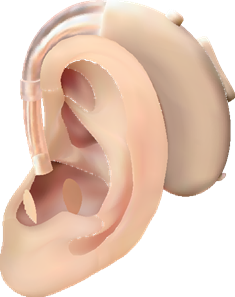 A hearing aid makes sounds louder and can help a person with hearing loss hear better.
A hearing aid makes sounds louder and can help a person with hearing loss hear better.
If hearing aids are used, the person using them should try to wear them all the time they are awake. This is especially important for children because they learn by listening to everything happening around them.
Hearing aids use batteries, and these usually need replacing every few days.
You can learn more about hearing aids and how to manage basic problems through instruction sheet about hearing aids.
8.3 COCHLEAR IMPLANTS
A cochlear implant is an electronic medical device for people with a severe or profound hearing loss, for whom hearing aids do not work. Unlike hearing aids, the cochlear implant converts sounds into electric signals. These signals stimulate the little hairs in the inner ear and the signals go up the hearing nerve to the brain. The brain understands these sounds or speech and so the person may be able hear better.
Cochlear implants need to be surgically implanted in the ear.
The cochlear implant has the following parts:
- A microphone to pick up sound.
- An external processor that sits behind the ear or on the head, and has a similar appearance to a hearing aid. This changes sound into electrical signals.
- A transmitter that sends the electrical signal to the internal implant.
- Internal part which is placed under the skin behind the ear during an operation. It sends electrical signals into the cochlea to activate the hearing nerve and allow hearing.

8.4 SIGN LANGUAGES
Children and adults who are deaf (have severe or profound hearing loss) can benefit from use of sign language. Sign languages are an important alternative to spoken languages. Sign languages use movement and positioning of the hands, arms and mouth to communicate. Sign languages are similar to spoken languages. They are complex, and can communicate different ideas, thoughts, and feelings.
There are over 250 different sign languages used around the world today.
Learning sign language is especially important where hearing devices are not preferred; are not beneficial; or are unavailable. This will ensure that the child can communicate and get education through sign language.
Families/carers and teachers can learn to use sign language so that they can communicate well with the deaf person.
Some words in Cambodian sign language
8.5 THERAPY AND TRAINING
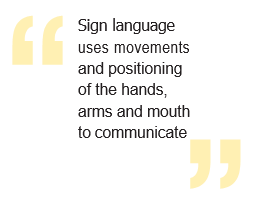
- Speech and language therapy to help them to learn spoken language.
- Auditory training teaches children how to listen, and how to use hearing aids to get the most benefit.
8.6 OTHER ASSISTIVE TECHNOLOGIES
Use of technology can support people with hearing loss to communicate better. Some examples are:
- Loop systems or FM systems, especially in school settings, meeting rooms, theatres etc
- Alarm signallers
- Captioning services


